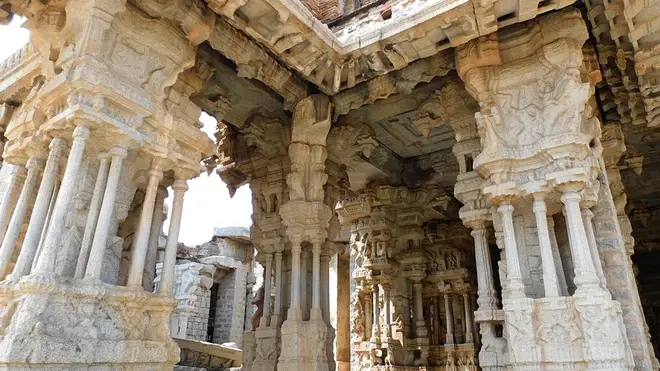On Air Now
Relaxing Evenings with Zeb Soanes 7pm - 10pm
19 May 2022, 16:46 | Updated: 25 May 2022, 10:59

In the Vijaya Vittala Temple in Hampi, India, 56 pillars produce musical sounds, fascinating visitors for over 500 years...
Within the Vijaya Vittala Temple in Hampi, South India are 56 pillars, each 3.6 metres high, which when gently tapped produce delicate musical notes.
Tourists have been travelling to the UNESCO World Heritage Site for years to hear the over 500-year-old temple’s mesmerising music.
The pillars, named SaReGaMa, are so-called after the first four notes (svaras) of the standard scale in Indian classical music – similar to the Western Do Re Mi Fa (solfège).
Together, they hold up the 15th-century ‘Ranga Mantapa’, a main attraction within the temple complex. Resembling an open pavilion, it was most likely used for music and dancing.
Across the hall, primary larger pillars are surrounded by seven smaller pillars that each ‘play’ one of the seven notes in the Indian classical music scale. Made of pieces of huge resonant stone, the cluster of musical pillars vary in height and width, in order to produce the different tones.
Take a listen below.
Read more: The loudest recorded sound in history literally sent shockwaves around the world

Music pillars of Hampi – Travel Karnataka
Vijaya Vittala is not the only temple to feature these musical pillars. For around 200 years, these harmonious hallmarks represented an exciting revolution in architecture from the 14th to 16th century, particularly in the south of India.
Scholars have presumed that the pillars were once tapped, or sometimes blown into, to accompany chants and devotional performances.
Today, the pillars at Vijaya Vittala are cordoned off to prevent further damage to the stone instruments, a move many temples have made to protect their older structures from curious tourists eager to hear the musical architecture.
Read more: Toddler singing Indian classical music with his father will melt your heart

Elsewhere in South India, the Nellaiappar Temple in Tirunelveli boasts a line of musical pillars, which are arranged so that when one pillar is tapped, a neighbouring one reverberates, producing a bell-like sound.
As well as singing pillars, temples have been known to feature other musical architecture, such as staircases.
North-east of Tirunelveli, at the Airavateshwara temple in Darasuram, a staircase leading into the temple is surrounded by a metal grate. This is to protect this set of ten steps, as when someone walks on them, they ‘play’ the first seven notes of the Indian classical music scale.
The steps in this 12th-century temple have been sectioned off after years of serious damage, due to so many visitors coming to walk on the stairs and hear their music.
Read more: This piano staircase social experiment revealed how music makes everything better
India isn’t always about Taj Mahal!
— SHRIRANGA🧢 (@ShrirangaPV) May 10, 2020
The contribution of Pallavas, Cholas, Pandyas in the field of architecture were never highlighted.
Nellaiappar Temple, Tirunelveli, Tamil Nadu. Built in 700CE.
Musical stone pillars can be found in this temple. pic.twitter.com/lCEeh8lzvR
All the above temples are dedicated to Lord Shiva, one of the principal deities of Hinduism, who has a prominent association with dance and music. Which likely explains the powerful presence of musical architecture in these temples...
It is notable that the temples spoken about are dedicated to Lord Shiva, one of the principal deities of Hinduism, who has a prominent association with dance, and music, which could explain the powerful presence of musical architecture in these temples.